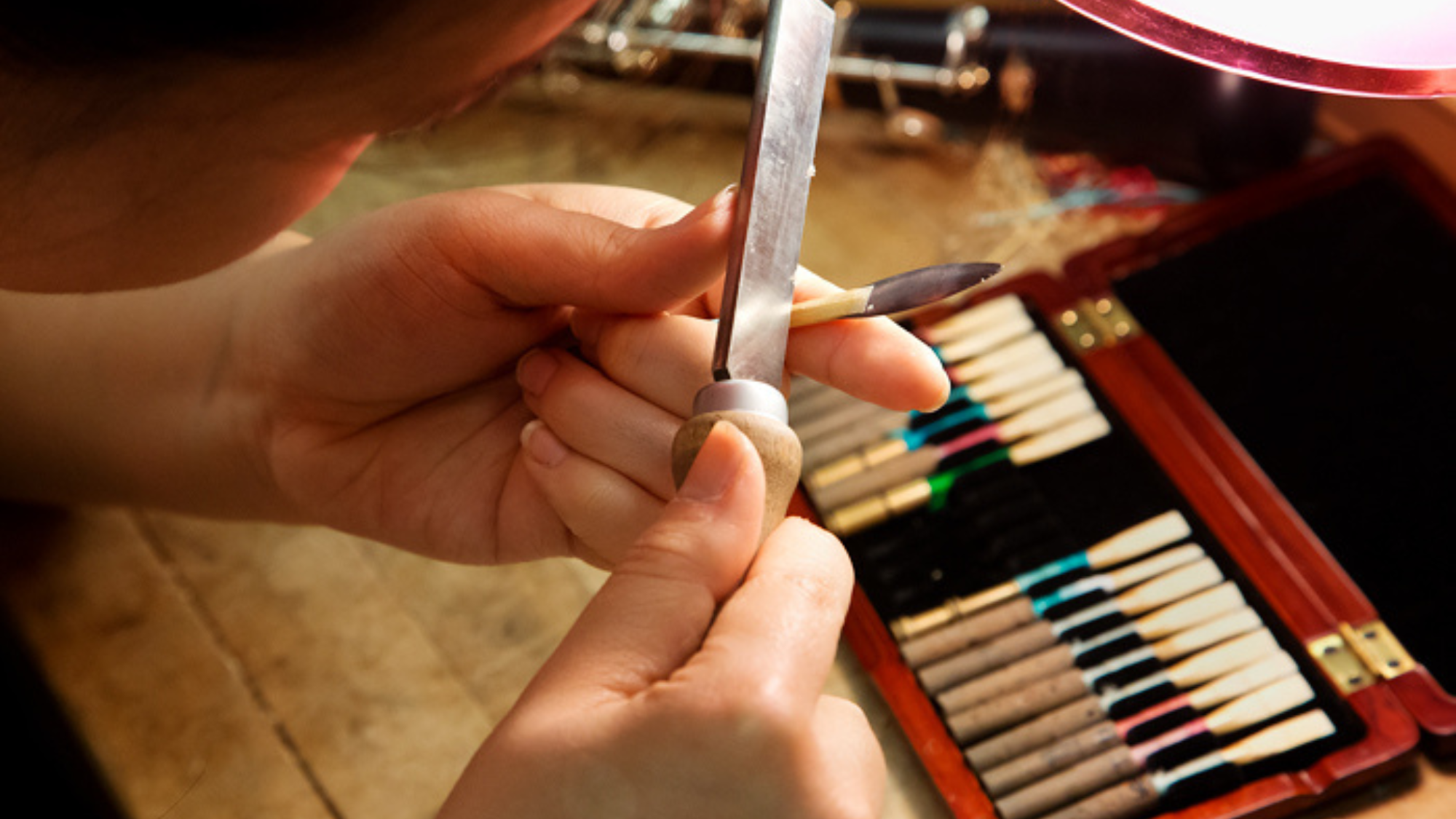Introduction
When playing in the jazz style, performing with correct notes, rhythms and using authentic jazz articulations are necessary requirements for creating a great improvised solo. However, in addition to these requirements, many jazz saxophonists also use other special techniques which add a great deal of expressiveness and excitement to their performance. Some of these techniques are subtoning, growling, and split tones.
Subtoning
When performing in the classical style, saxophonists strive to maintain a consistent timbre for each note throughout the entire range of the saxophone. This concept is most evident when listening to classical saxophonists play in the lower range of the instrument. These lower register notes, which have the same timbre as notes in the middle and upper range of the saxophone, are not manipulated in any way to reduce the amount of edge in the tone.
Subtoning is a technique used by saxophonists to manipulate the timbre of notes in the lower register by removing all the edge from the sound. This technique, which is sometimes called for in classical saxophone literature, is most commonly used in the performance of jazz. When performing in the jazz style, subtoning is used most often when performing standard jazz literature, especially jazz ballads.
To sub-tone in the lower register, the saxophonist should pull the lower jaw back towards the face while dropping it slightly downward. These movements will reduce the amount of embouchure pressure on the mouthpiece while increasing the amount of lower lip on the reed, giving the note a sub-tone quality. This technique is used by many jazz saxophonists to give the lower register a more expressive, pleasing timbre.
However, since this is an advanced technique, beginning saxophonists should avoid subtoning when first learning to form the embouchure, as it could lead to stability problems. Only after the embouchure has been thoroughly established should performers begin learning this technique. In addition, saxophonists should always be consciously aware of when they are subtoning so it does not become a habit used indiscriminately every time the lower register is played. If subtoning becomes an unconscious habit, it can be very difficult to break later on when the saxophonist is performing in the classical style and does not wish to use it. Nevertheless, developing this technique is a must for saxophonists who aspire to play in the jazz style. When subtoning is performed correctly and used within the appropriate context, it provides the jazz saxophonist with a new expressive technique for the lower register.
Growling
Growling is a technique primarily used by saxophonists when performing commercial and jazz music. This technique changes the timbre of a note giving it a raspy, growling quality adding much intensity and expression to the tone.
There are two methods for producing a growl on the saxophone. The first method requires the saxophonist to hum while playing a note. It does not matter what pitch is hummed but it is usually not the same pitch as the note being played and most of the time, the hummed pitch is in the middle to lower range of the voice. The hummed note should be thought of as a drone note that is in a comfortable range for the saxophonist to hum since the pitch of the note is not a factor in producing the growl.
When first attempting to produce a growl, the saxophonist should play a note in the middle register of the instrument. After beginning the note, the saxophonist should then try to hum while not allowing the note to stop. When initially attempting to growl, the saxophonist should increase the pressure and amount of airflow coming from the lungs since the extra pressure and volume will assist in pushing air past the humming vocal chords. It is also very helpful to hum loudly, as this will make growling easier.
When humming to play a growling note, the saxophonist will be able to hear both the note being played and the note being hummed, which may cause some concern. However, the hummed note will not be audible to audience members since they will be some distance away from the performer and the growling note will cover the humming sound created by the voice.
A second method to create a growl, which is not as common as the first, is to allow a small stream of air to escape out of one corner of the mouth while playing. As the air escapes, the saxophonist buzzes the lips at the corner spot where the air is escaping, which will produce a growling sound. Growled notes produced by this method have a slightly different timbre than notes produced by humming and may be preferred by some saxophonists.
Growling is a technique that may be difficult to do at first but with some practice, most saxophonists are successful at producing a growl either by humming or by buzzing the lips. Some saxophonists use both methods of growling, selecting a particular technique based on the notes being played, the style of music, and the specific performance situation.
Split Tones
The technique of playing split tones is an advanced skill also commonly used by saxophonists when playing commercial and jazz music. This technique, usually applied to notes in the upper and altissimo register, alters a note’s timbre giving it a raspy, growling quality. Split tones, which sound similar to growling, are produced without humming or buzzing the lips. There is also a noticeable difference in the timbre of a split tone note which when compared to the two methods of growling, make it the preferred technique for many jazz saxophonists, especially when playing in the upper and altissimo registers. The timbre of split tone note is most comparable to the tone produced when playing a multi-phonic note since a split tone is actually a combination of the same note being sounded in two octaves at once.
Before attempting to produce a split tone in the upper or altissimo register, the saxophonist should first practice playing notes in these registers producing a pure, clean tone that is in tune. After this is accomplished the process of learning to play split tones can be undertaken. To begin, the saxophonist should play the note of choice in a long, sustained manner. To change this note into a split tone note, saxophonists should push the lower jaw forward taking more reed into the mouth while simultaneously applying more lip pressure into the center or heart of the reed. To assist in producing the split tone, the saxophonist should also increase the air pressure blowing a narrow, focused, forceful stream of air into the instrument.
It may take some experimentation to determine the correct balance of air pressure, lip pressure, and jaw placement needed to produce a split tone note. It may also be helpful not to use the octave key when initially playing a split tone note, especially if the note sounding is clean and pure. Playing upper register and altissimo notes without the octave key being depressed may increase the chances of a pure note splitting. Some saxophonists also find that angling the mouthpiece slightly downward as it enters the mouth also assists in producing a split tone. By doing this the air stream is directed more across the tip of the mouthpiece rather than directly into it.
Other factors that affect the production of split tones are reed strength, mouthpiece design and the specific fingerings used for upper register and altissimo notes. Altissimo notes have several fingering options, some of which may be more conducive to producing split tones. Saxophonists should experiment with these fingerings to see if certain ones have a tendency to produce clean tones while others produce split tones and use the appropriate fingering for the effect desired.
The split tone technique is a favorite device used by many saxophonists, especially those who perform smooth jazz, rhythm and blues, funk, fusion, and rock. By developing the ability to play split tones, saxophonists will be much more adept in playing a wide range of musical styles.
Summary
Subtoning, growling, and using split tones are highly effective techniques that can be used to enhance jazz performance and create an expressive, improvised solo. However, it is important as with any technique, for saxophonists to listen to recordings of master jazz artists performing these effects and imitate the sounds they hear. Through careful listening and practice, jazz saxophonists should be able to incorporate these techniques in their playing style.






